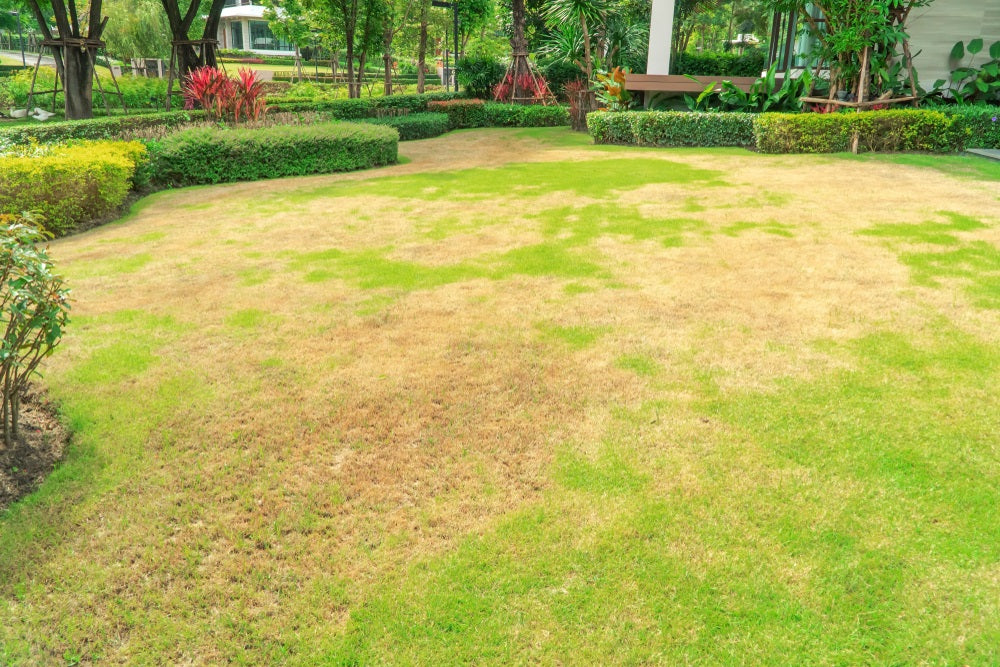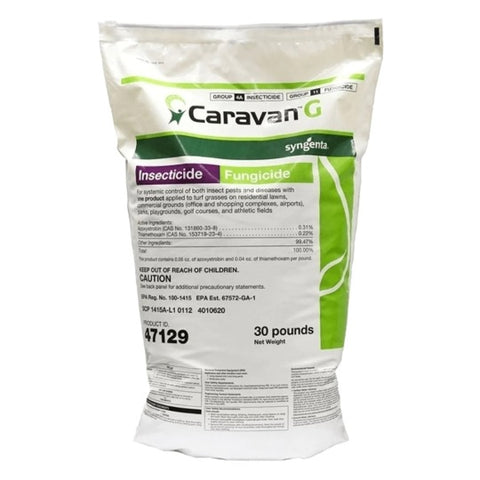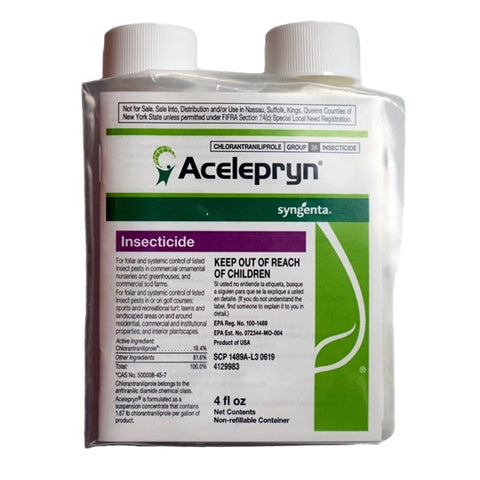Make Getting Rid of Chinch Bugs a Cinch
A lush, green lawn is the pride of many homeowners, but various pests, including the notorious chinch bugs can threaten it. These tiny insects can wreak havoc on your turf, causing brown patches and thinning grass.
In this blog, we'll explore the signs of a chinch bug infestation and provide effective strategies to get rid of them, allowing you to reclaim the health and beauty of your lawn.
Identifying Chinch Bug Damage

Chinch bugs are small, black, or dark brown insects that measure around 1/6 to 1/5 inch in length. While they may be tiny, their damage can be significant. Chinch bugs feed on grass blades by piercing them and extracting sap, which results in yellowing, browning, and eventually death of the grass. Their damage often resembles drought stress or other lawn diseases, making it crucial to identify the presence of chinch bugs early.
Here's a more detailed exploration of the signs of chinch bug damage:
Yellowing Grass
Chinch bugs feed on grass by puncturing the blades with their piercing-sucking mouthparts and extracting sap. As they feed, they inject a toxin into the grass that disrupts the flow of nutrients. One of the earliest signs of chinch bug damage is yellowing grass, resembling drought stress. This yellowing is often visible in irregular patches throughout the lawn.
Stunted Growth
Chinch bug feeding weakens the grass, leading to stunted growth. The affected areas may fail to thrive and remain shorter than the surrounding healthy grass. This stunted growth contributes to the overall patchy appearance of the lawn.
Thinning Turf
As chinch bugs continue to feed and damage the grass, the affected areas experience thinning. The grass becomes sparse, and the soil may become more exposed. This thinning is often most noticeable in sunny areas of the lawn, as chinch bugs thrive in warm conditions.
Brown Patches
The damage caused by chinch bugs progresses, and affected areas can turn brown. These brown patches may be mistaken for other lawn issues, such as fungal diseases or uneven watering. Chinch bug damage, however, tends to have a distinctive irregular shape, with a gradual expansion from the initial point of infestation.
Edge Damage
Chinch bugs often target grass along edges, such as sidewalks, driveways, and lawn borders. This preference for sunny edges is due to the warmer conditions these areas provide, creating an ideal environment for chinch bug activity. Pay close attention to these edges when inspecting for signs of damage.
Presence of Chinch Bugs
While the bugs themselves are small (around 1/6 to 1/5 inch), spotting them can clearly indicate an infestation. Carefully examine the damaged areas, particularly the interface between healthy and damaged grass, as chinch bugs tend to congregate in these transitional zones.
Drought-Like Symptoms
Chinch bug damage can mimic the symptoms of drought stress, as both conditions result in yellowing and wilting of the grass. However, while drought stress affects the entire lawn uniformly, chinch bug damage typically appears in patches, making it essential to differentiate between them.
Related: Meet The Grubs That Cause Your Lawn Damage
Effective Strategies for Chinch Bug Control

Understanding these signs and regularly inspecting your lawn for abnormalities will enable you to detect chinch bug infestations early on. Early intervention is crucial for effective control and preventing extensive damage to your lawn.
Biological Controls
Introduce beneficial insects that prey on chinch bugs, such as ladybugs, spiders, and predatory beetles. This natural approach can help maintain a balance in your lawn ecosystem.
Insecticidal Soaps and Neem Oil
Insecticidal soaps and neem oil are effective and environmentally friendly options for controlling chinch bugs. These substances disrupt the insects' feeding and reproductive processes without harming beneficial insects or the environment.
Diatomaceous Earth
Diatomaceous earth is a natural, abrasive substance that can be sprinkled over affected areas. It acts as a chinch bug killer by damaging the bugs' exoskeleton, leading to dehydration and death. You’ll need to reapply after rain or irrigation.
Adjusting Watering Practices
Chinch bugs prefer dry conditions, so adjusting your watering practices can make your lawn less hospitable to them. Water deeply and infrequently, ensuring your lawn receives around 1 to 1.5 inches of water weekly.
Chemical Insecticides
If the infestation is severe, chemical insecticides may be necessary. Choose a product specifically designed for chinch bug control, and follow the manufacturer's instructions carefully. Apply the insecticide when chinch bugs are in their nymphal stage for optimal effectiveness.
Recommended Pest Control Products
When combating chinch bugs and maintaining a vibrant, healthy lawn, choosing the right pest control products is crucial. We recommend the following products available at the Golf Course Lawn Store, known for their effectiveness in chinch bug control:
Caravan G Insecticide and Fungicide
Caravan G Insecticide and Fungicide is a versatile solution that addresses chinch bug infestations and tackles fungal issues. This dual-purpose product provides comprehensive protection for your lawn, ensuring both insect pests and diseases are kept at bay. Its effectiveness against chinch bugs and its fungicidal properties makes it an excellent choice for integrated pest management.
Acelepryn SC Insecticide Liquid — Grub and Armyworm Control
Acelepryn SC Insecticide stands out as a reliable solution for liquid control of grubs and armyworms. This product offers a systemic approach to pest control, providing long-lasting results. Its liquid form ensures even distribution, effectively targeting chinch bugs, grubs, and armyworms. Acelepryn SC is known for its low impact on non-target organisms, making it an environmentally friendly choice.
Acelepryn G Insecticide — Grub and Armyworm Control
Specifically formulated for granular application, Acelepryn G Insecticide provides convenient and efficient control of grubs and armyworms. The granules ensure targeted coverage, allowing you to treat affected areas with precision. Acelepryn G is renowned for its extended residual activity, offering season-long protection against chinch bugs and other turf-damaging pests.
Mirimichi Green Pest Control
Mirimichi Green Pest Control is a sustainable and environmentally friendly option for those seeking natural pest control solutions. This product utilizes plant-based ingredients to repel and control pests, providing a safer alternative for your lawn. With Mirimichi Green Pest Control, you can protect your turf without compromising eco-friendliness.
Before using any pest control product, it's essential to read and follow the manufacturer's instructions for application and safety guidelines. Consider the specific needs of your lawn and choose the product that aligns with your pest control goals, whether it's targeting chinch bugs, grubs, or other harmful insects. By investing in these recommended products, you can take proactive steps toward maintaining a resilient and lush lawn.
Related: Pest Control For Your Lawn | A Complete Guide
Dealing with chinch bugs in your lawn requires a proactive approach and a combination of strategies. By maintaining a healthy lawn, implementing early detection methods, and using environmentally friendly control measures, you can effectively eliminate chinch bugs and enjoy a vibrant, green lawn once again. Remember to monitor your lawn regularly and adjust your practices as needed to keep these pesky insects at bay.
Golf Course Lawn Store can help you on your way to achieving a Golf Course Lawn. Become the envy of your neighborhood and browse our full range of products today.


